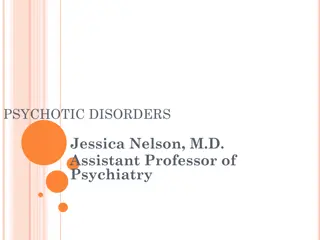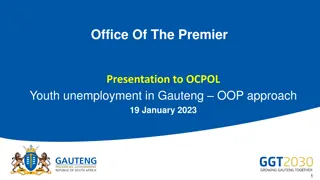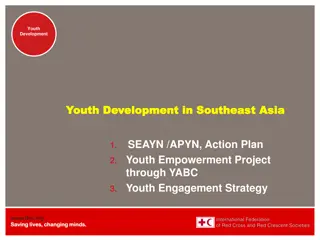Understanding Psychotic Symptoms in Children and Youth
Psychotic symptoms in children and youth can manifest in various forms including hallucinations, grief-related apparitions, cultural influences, hypnagogic experiences, and imaginary friends. It's important to differentiate between non-pathological experiences and clinical psychosis. Psychotic symptoms can also be associated with disorders like Major Depressive Disorder and PTSD, each presenting distinct characteristics and manifestations.
Download Presentation

Please find below an Image/Link to download the presentation.
The content on the website is provided AS IS for your information and personal use only. It may not be sold, licensed, or shared on other websites without obtaining consent from the author. Download presentation by click this link. If you encounter any issues during the download, it is possible that the publisher has removed the file from their server.
E N D
Presentation Transcript
Psychosis in the Primary Care Office Andres J. Pumariega, M.D. Professor and Chief, Division of Child and Adolescent Psychiatry Department of Psychiatry, UF College of Medicine
Prevalence of Psychotic Sx in Children and Youth Kelleher, et al. (2012): Systematic lit review of 3597 studies, 19 met criteria for inclusion The median prevalence of psychotic symptoms among children aged 9 to 12 was 17% and among adolescents aged 13 to 18 was 7.5%. Decline in incidence in young people over time/ as older and more mature More prevalent than among adults (5 %) Thin line between psychosis and immature cognitive processes, reality testing, and fantasy, which is normal for kids Imaginary friends Make believe play Though most kids do have intact reality testing for normative hallucinatory experiences
Psychotic Symptoms in Children and Youth Non-pathological forms of hallucinations Grief and Loss: Grief/ loss and apparition of the lost person (can come with feeling of comfort or reunion) Cultural: Religious apparitions in midst of anxiety/ stress (congruent with faith tradition- e.g. Virgin for Catholics, Jinn for Muslims) Hypnogogic: Hallucinations/ hallucinosis at time of sleep twilight (misinterpretation of environmental stimuli) Nighttime monsters of childhood (usually relate to anxiety) Imaginary friends for kids who feel isolated/ lonely, can be transitional object Major difference: reality testing (ability to tell between real and not real). By definition, clinical psychosis includes failure of reality testing
Disorders that can include Psychotic Sxs: MDD Psychotic sx usually seen when MDD is severe Primarily auditory and visual hallucinations, some somatic delusions and delusions about death Symptoms are mood congruent, i.e. with depressive content Rarely have delusional thinking, at times can have somatic delusions of body rotting or serious/ terminal illness Can have thought disturbance with high concreteness, slow thought process, slow processing Catatonia- most common with psychotic depression: extreme psychomotor slowing, inability to move or ultra slow movement for extended period (can be hours), waxy flexibility , usually underlying delusions of death or guilt/ divine punishment
Disorders that include can Psychotic Sxs: PTSD Hallucinations (auditory, visual, olfactory, tactile) can be flashback fragments of traumatic events (voice or apparition of perpetrator, somatic memory of smell or touch, etc.) Rarely out of context for the traumatic event Can be hypnogogic (when about to sleep, in dark) or upon awakening from nightmare; also with flashback) Hyper-startle can seem like paranoia
Disorders that can include Psychotic Sxs: Bipolar Disorder Psychotic sx again indicators of severity; usually during manic states (at times during depressive states) Auditory hallucinations can be intense or indicators of hyperacusis (hearing things others can t) or special visual acuity Psychotic sx again mood congruent, can change with mood (manic or depressive) Manic delusions are usually grandiose (special powers or abilities, immortality), can actually try to fly or jump thinking can survive (like super-heroes) Can include thought disturbance (esp. tangentiality, at times loose associations), often with pressured speech Catatonia- most common with psychotic mania (can be catatonic agitation) or depression (immobile catatonia): inability to move or ultra slow movement for extended period (can be hours), waxy flexibility , usually underlying delusions of grandiosity (prevent catastrophe by not moving) Schizoaffective disorder: Mood disorder PLUS schizophrenic symptoms; try to establish if has schizophrenic sx during euthymic time period. Have better prognosis than plain schizophrenia.
Disorders that include Psychotic Sxs: Schizophrenia Most common association with psychotic symptoms, though least frequent in prevalence (1 % of population, less in children and youth) By definition, schizophrenia includes full range of psychotic symptoms Positive psychotic symptoms Auditory, visual, tactile, olfactory, or gustatory hallucinations, with bizarre or incongruent responses Delusional beliefs (irrational or unreal beliefs, often paranoid, with distortion or mis-interpretation of environmental stimuli- including ideas of reference, ideas of thought control, etc.) Thought disturbance (thought interruption/ disappearance, looseness of associations, tangentiality), derealization/ depersonalization- someone else taking over their bodies) Can include catatonia with underlying delusional beliefs Psychotic symptoms are mood incongruent, with inappropriate response to delusions and hallucinations, also experienced largely outside their minds/ heads Negative symptoms Disturbance of emotions and affect (flat, inability to experience emotions or become overwhelmed by them) Difficulty initiating conversations/ communication, lack of verbal output Avolition, lack of motivation Social withdrawal
Neurobiological Correlations with Psychosis Alemany et al. (2011) first allelic association with psychotic symptoms, demonstrating that persons exposed to childhood abuse who are Met carriers at the BDNF-Val66Met polymorphism are more likely to report psychotic symptoms, compared to persons who are Val homozygous. MRI imaging research on adolescents with psychotic symptoms has demonstrated a number of anatomical and functional abnormalities, including in the cingulum and orbitofrontal cortex, while digital tractography imaging has revealed reduced integrity of fronto-temporal pathways (Jacobson et al., 2010). Laurens et al. (2010) found executive functioning and verbal and working memory problems, as well as error-processing dysfunction in a sample of young adolescents who reported psychotic symptoms in combination with speech or motor developmental delay and emotional/behavioral problems Blanchard et al. (2010) found neurocognitive deficits in speed of processing and in tests of receptive language in adolescents with psychotic symptoms. Motor abnormalities have also been demonstrated by a number of studies, with dopamine dysregulation a suggested mechanism.
Other Factors Contributing to Onset and Aggravation of Psychotic Sx in Children and Youth Substance use Classically hallucinogens, but can be induced by cocaine/ amphetamines (amphetamine psychosis) or potent cannabis (has hallucinogenic effects) Can be part of delirium related to substance (see below) Can kindle underlying vulnerability for psychotic disorders (about 10 % of onset of bipolar or schizophrenia can be considered excess incidence beyond expected); these can then be chronic Neurological Disorders Hallucinations seen with partial complex seizures (temporal lobe involvement) Can seem quite real but usually persons have reality testing Other medical- Delirium Hallucinations are usually not personalized (inanimate, animals, flashes of light, etc.) Cognitive impairment and mental confusion/ disorientation Often have intact reality testing and lack delusional thinking Appropriate response to hallucinatory experiences Causation: medical illness, medications (esp anticholinergics), environmental (organophosphate fertilizers, etc.) Medical emergency (high percent of death/ morbidity from underlying cause; race against time
Identification of Psychosis: Early Psychosis and Prodromal Psychosis Peak age of onset: Bipolar disorder later teens to 30 s, schizophrenia typically early 20 s However, can have onset of prodromal symptoms before full expression or initial full psychotic break Prodrome: Single psychotic symptoms without full picture For schizophrenia- negative symptoms plus single to transient psychotic symptoms; for bipolar- grandiosity plus psychotic sx. Can identify in early adolescence, can be as young as early elementary These are not substance related, though should be ruled out Intervention at time of prodrome- still experimental (low dose antipsychotic, antidepressants, cognitive behavioral therapy, O3FA s), some have shown delay or prevention of onset of full syndrome/ illness state
Significance of Psychosis, esp. Early Psychosis Bartels-Velthuis et al., (2010): Auditory hallucinations in children 7 to 8 years demonstrated only a minor association with psychopathology as measured by the Child Behavior Checklist (CBCL). However, when reassessed these children at ages 12 to 13 years, they found that psychotic symptoms, whether persistent or newly incident, were strongly predictive of CBCL-rated psychopathology (Bartels- Velthuis et al., 2011). While 57% of a general population sample of 11 to 13 years old who reported psychotic symptoms had a diagnosable Axis-1 disorder, nearly 80% of a general population sample of 13 to 15-years old who reported psychotic symptoms had an Axis-1 disorder.
Treatment of Psychosis: Pharmacotherapy Primary role of primary care is identification- then referral to psychiatry! (For both evaluation and treatment). Problem: lack of access Treatment of underlying disorder Depression- antidepressants, if psychotic adding antipsychotic Anxiety- SSRI s and alpha agonists; rarely adding antipsychotic PTSD- Alpha agonists, prazosin, SSRI s; rarely adding antipsychotic Bipolar disorder- atypical antipsychotic, mood stabilizers (valproate, Lithium) Antipsychotics Schizophrenia- Primary agent, primarily atypical antipsychotics since higher results with negative as well as positive symptoms First gen antipsychotic reserved for non-response and acute management Secondary adjunctive agent (for all above with psychosis) Usually higher doses to treat acute episodes or psychotic breaks , then taper to maintenance doses (or eventually discontinue outside of schizophrenia) ECT- High response to psychotic depression, bipolar disorder, catatonia, and severe schizophrenia
Antipsychotics: Risks vs Benefits Benefits: Wide spectrum efficacy for psychotic symptoms Can also manage aggression/agitation Can target underlying serious disorders (bipolar, schizophrenia), possibly prevent decompensation Risks: Metabolic side effects (higher in kids) Extrapyramidal side effects (acute dystonic reactions, akathisia, cogwheel rigidity) Neuroleptic malignant syndrome (high mortality) Tardive dyskinesia and dystonia (risk of chronicity) Masking of other underlying condition(s), preventing other treatment
Treatment of Psychosis: Psychotherapy Psychosocial rehabilitation Focus on social skills, reducing isolation, navigating social contexts to seek support and resources Can be implemented in schools or job/employment site along with VR Family Psychoeducation Educate families on origins of psychotic symptoms and associate disturbances Help families develop skills to de-conflict explosive situations and motivate patients CBT: Here and now exploration of recent experiences to Gain an understanding of how predisposing factors may have underpinned the current links between experiences, thoughts, emotions, and behaviors How that increases the individual s vulnerability to developing mental health problems Development of skills to identify and address unhelpful thinking patterns and behaviors
Treatment of Psychosis: Psychotherapy (2) CBT for Psychosis Shared formulation to inform the understanding, and maintenance, of psychotic symptoms and to aid in making sense of these experiences Normalization of the psychotic experience to address the stigma that often is associated with psychosis Acceptance of (living with) psychotic symptoms, which highlights the primary goal of this approach to reduce distress relating to the symptoms, rather than attempting to alter the occurrence of the symptoms. Can be used in prodromal states and preventively Avatar therapy (T Craig, UK) Therapist-assisted, computer-based intervention in which therapists facilitate a conversation between patients who are experiencing persistent persecutory auditory hallucinations (i.e. hearing voices) and a visual representation of one of the persecutory voices (i.e. the avatar). Helps person experiencing delusions (ideas that are not true) and hallucinations (change the way they think about and respond to these experiences, with goal to make them less distressing and less impairing in day-to-day life.























